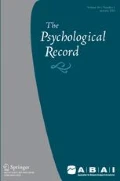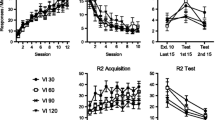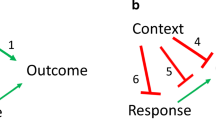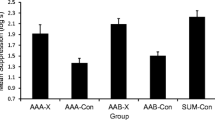Abstract
Humans were exposed to a multiple fixed-interval 20- s/variable-ratio 15 schedule of lever pressing, with an anagram solution task, the “masking task, ” either concurrent with, or alternating with the operant task. In Experiment 1, subjects with the concurrent anagram task, the “masked” subjects, did not discriminate between the different components of the operant task. Subjects with the alternating anagram task, the “unmasked” subjects, did discriminate between the two components of the operant task. In Experiment 2, the operant response rates of the masked subjects did not decline during extinction of operant responding. the response rates of the unmasked subjects declined greatly during extinction. In Experiment 3, only masked subjects were run and both the operant task and the anagram task were put on extinction. Operant response rates and anagram response rates did not decline during extinction. Experiment 4 alternated masked and unmasked operant sessions in counterbalanced fashion across different subjects. Results replicated Experiments 1, 2, and 3, and some subjects developed discriminative responding during the unmasked sessions which was maintained during subsequent masked responding. The behavior of the subjects during the present experiments is likely to be controlled by: implicit task demands, explicit task demands (i.e., Instructions), attended-to reinforcement contingencies, and contingency-related subject-produced verbal rules.
Similar content being viewed by others
References
ATWATER, J. B., & MORRIS, E. K. (1988). Teacher’s instructions and children’s compliance in preschool classrooms: A descriptive analysis. Journal of Applied Behavior Analysis, 21, 157–167.
BARON, A., & GALIZIO, M. (1983). Instructional control of human behavior. The Psychological Record, 33, 495–520.
BARON A., KAUFMAN, A., & STAUBER, K. A. (1969). Effects of instructions and reinforcement-feedback on human operant behavior maintained by fixedinterval reinforcement. Journal of the Experimental Analysis of Behavior, 12, 701–712.
FRANCIS, W. N., & KUCERA, H. (1982). Frequency analysis of English usage. Boston: Houghton-Mifflin.
GALIZIO, M. (1979). Contingency-shaped and rule-governed behavior: Instructional control of human loss avoidance. Journal of the Experimental Analysis of Behavior, 31, 53–70.
HARZEM, P., LOWE, C. F., & BAGSHAW, M. (1978). Verbal control in human operant behavior. The Psychological Record, 28, 405–423.
HAYES, S. C., BROWNSTEIN, A. J., HAAS, J. R., & GREENWAY, D. E. (1986). Instructions, multiple schedules, and extinction; Distinguishing rulegoverned from schedule-controlled behavior. Journal of the Experimental Analysis of Behavior, 46, 137–147.
HAYES, S. C., BROWNSTEIN, A. J., ZETTLE, R. D., ROSENFARB, I., & KORN, Z. (1986). Rule-governed behavior and sensitivity to changing consequences of responding. Journal of the Experimental Analysis of Behavior, 45, 237–256.
KNAPP, T J. (1987). Skinner’s analysis of perception/cognition. In S. Modgil & C. Modgil (Eds.), B. F. Skinner: Consensus and controversy. Philadelphia, PA: Falmer.
LOWE, C. F. (1979). Determinants of human operant behavior. In M. D. Zeiler & P. Harzern (Eds.), Reinforcement and the organization of behavior. New York: Wiley.
LOWE, C. F., HARZEM, P., & HUGHES, S. (1978). Determinants of operant behavior in humans: Some differences from animals. Quarterly Journal of Experimental Psychology 30, 373–386.
MAYZNER, M. S., & TRESSELT, M. E. (1958). Anagram solution times: A function of letter order and word frequency. Journal of Experimental Psychology 56, 376–379.
ORNE, M. T. (1962). on the social psychology of the psychological experiment: With particular reference to demand characteristics and their implications. American Psychologist, 17, 776–783.
PITTENGER, D. J., PAVLIK, W. B., FLORA, S. R., & KONTOS, J. M. (1988). Analysis of the partial reinforcement extinction effect in humans as a function of sequence of reinforcement schedule. American Journal of Psychology 101, 371–382.
POPPEN, R. (1982). Human fixed-interval performance with concurrent programmed schedules: A parametric analysis. Journal of the Experimental Analysis of Behavior, 37, 251–266.
SCHOENFELD, W. N., & CUMMING, W. W. (1963). Behavior and perception. In S. Koch (Ed.), Psychology: A study of a science (Vol. 5). New York: McGraw-Hill.
SHIFFRIN, R. M., & SCHNEIDER, W. (1977). Controlled and automatic human information processing: II. Perceptual learning, automatic attending, and a general theory. Psychological Review, 84, 127–190.
SPENCE, K. W. (1966). Cognitive and drive factors in the extinction of the conditioned eye blink. Psychological Review, 73, 445–458.
SPENCE, K. W., HOMZIE, M. J., & RUTLEDGE, E. F. (1964). Extinction of the human eyelid Cr as a function of the discriminability of the change from acquisition to extinction. Journal of Experimental Psychology, 68, 376–381.
SPENCE, K. W., & PLATT, J. R. (1967). Effects of partial reinforcement on acquisition and extinction of the conditioned eyeblink in a masking situation. Journal of Experimental Psychology, 74, 259–263.
WEINER, H. (1983). Some thoughts on discrepant human-animal performances under schedules of reinforcement. The Psychological Record, 33, 521–532.
Author information
Authors and Affiliations
Additional information
The present experiments were reported at the 1987 and 1988 meetings of the Southeastern Association for Behavior Analysis.
Rights and permissions
About this article
Cite this article
Flora, S.R., Pavlik, W.B. & Pittenger, D.J. Effects of A Masking Task on Schedule Discrimination and Extinction in Humans. Psychol Rec 40, 83–104 (1990). https://doi.org/10.1007/BF03399573
Published:
Issue Date:
DOI: https://doi.org/10.1007/BF03399573




